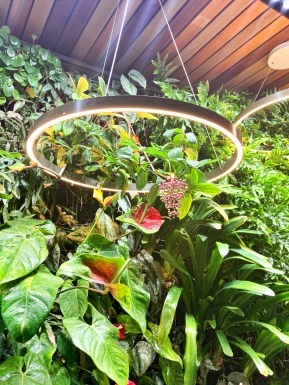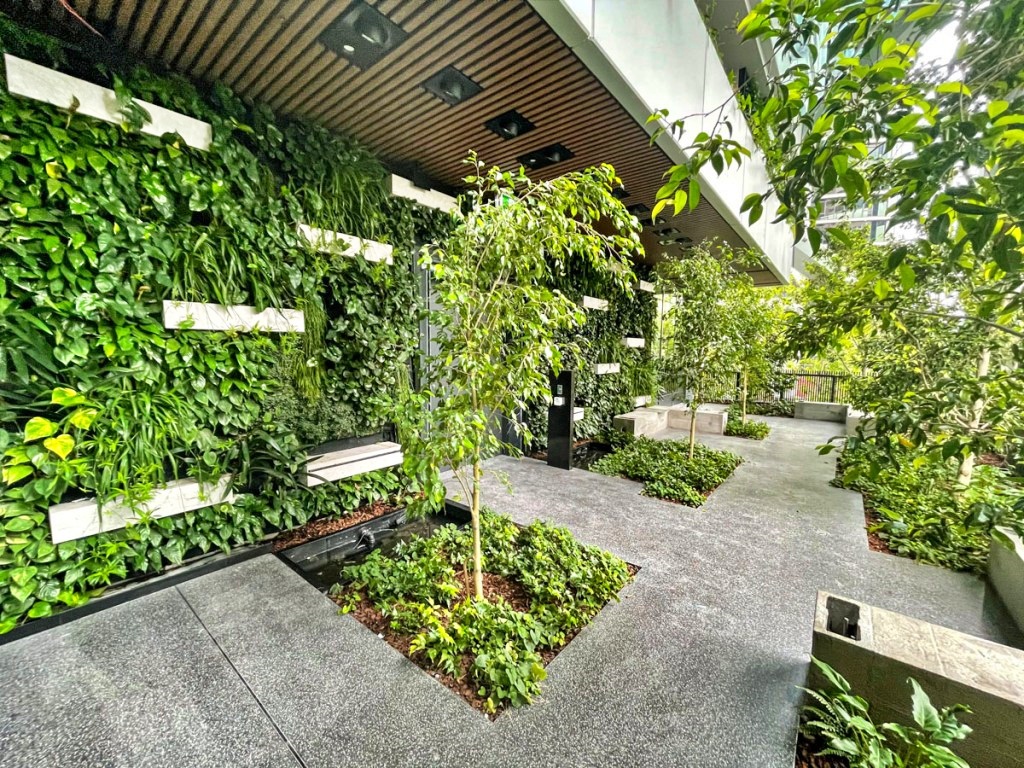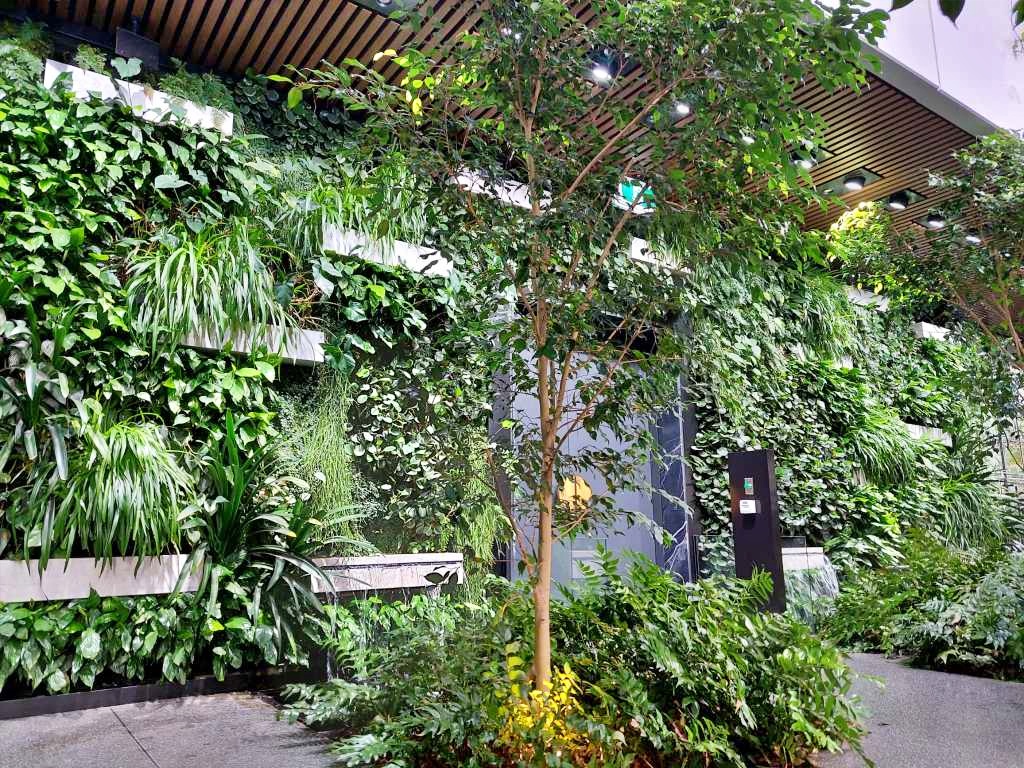Ecologies are living systems, relentless processes simultaneously testing additions, modifying each change on-site and within real-time based upon modifying pressures whilst persistently feeding off excesses and by-products. This unfolding generates integrated systems whereby each ‘loss’ or ‘failure’ becomes fodder for the next generation to feed off whilst repeatedly using survival strategies to push boundaries, based upon effective and immediate resource management and conservation. This leads to perpetual adaptation and evolution towards ever more integrated and complex systems as solutions.
Living architecture systems are varied due to the convoluted nature of architecture, its relationship with achieving high density, maximising use per square meter of footprint and utility for inhabitants and contributions towards visual amenity of onlookers.
Consequently, many system types have developed to allow us to host plants on buildings, i.e., on podium, on and upwards above ground level. Each system is tailored to suit areas the host architecture presents to be colonised by plants, whether that is penetrations into the ground, available space on vertical surfaces such as walls, projections from the host wall surface, on raised floors or supports, on roof spaces or even voids within or around the host building where colonising zones may be suspended.
 In most cases, weight bearing capacity of the host architecture initiates the first conversations regarding feasibility for the building to support planted zones, followed by irrigation, drainage and finally though not least exposures and available resources to sustain healthy and thriving plantings.
In most cases, weight bearing capacity of the host architecture initiates the first conversations regarding feasibility for the building to support planted zones, followed by irrigation, drainage and finally though not least exposures and available resources to sustain healthy and thriving plantings.
Achieving notable longevity, stability and sustainability requires integrating living architecture technologies with the host architecture to achieve stable compatibilities. This is akin to engineering an engine into a car or designing a functional component into an engine. The two require support and harmony, a back-and-forth flow of input and output to generate a balance the system can manage to maintain without experiencing excessive wear and tear.
Taking this further requires the hardware system to allow for hosting processes that generate biological balance, thus mitigating against process or biological fatigue. Afterall, the hardware, whether that be a planter on a balcony, a vertical garden ascending the sides of a building, a roof garden, or suspended columns within the atrium void of a building, all these components for all their complexity are ultimately merely hosts for plants and their associated biological processes of growth and development.
Achieving reduced biological fatigue necessitates designing with nature to support its universal and relentless process of building up and breaking down (entropy and syntropy). Anything that stands in the way of gravity, erosion through wind, sun, warmth, cold or mechanical bombardment or the inevitable processes of biological decomposition, will require the ability to withstand such fatigue or to rebuild and regenerate, to persist. Commercially, this entails working with components and processes requiring minimal inputs to maintain. Nature achieves this through slowly, incrementally, ‘growing’ systems one piece at a time.
Each incremental addition is tested by attrition with stresses and overloads generally leading to removal, ingestion and/or replacement with whatever the local environment supplies from allied developments, such as water, leaf litter, new seedlings or fauna emerging along organic tangents. Thus, the process relentlessly unfolds, with building block repeatedly adding to a falling away as the systems build and adapt to the pressures of the moment.
Fytogreen applies this core knowledge to focus upon generating living architecture planting solutions capable of adapting, reconfiguring and rejuvenating via natural and inherent processes of ecological unfolding. This is a particular approach to design.
In terms of vertical gardens, this entails utilising species originating from specific epiphytic or lithophytic ecologies in habitat, where they have evolved particular adaptations to thrive on the vertical plane, rather than attempting to force terrestrial, landscape, species to persist on the vertical, a mode of live which is significantly separated from their genetic imperative gained through generations of living in horizontal soils.
Using these species is certainly not sufficient to achieve sustainable, resilient and adaptive outcomes. We take this further by carefully researching their habitats and learning how and why each species is found there, the intricacies of each exposure, level of competition, limits of each environmental ‘fatigue or stress’ impact and what each species is doing within the mixed species community. Armed with such insights, we then apply each species based upon such observations, to generate pragmatic configurations to address each individual exposure type playing out over each host wall surface.
For Roof Gardens, Planter Boxes, FytoArbours, Column Gardens, Floating Wetlands and terrestrial applications, the same ecological mode of analysis and design apply. Roof gardens require species with specific and general adaptations to survive in shallow substrate profiles, heightened wind and sun exposures, fluctuating moisture gradients, root zone thermal fluctuations, etc.
We recognise the role of pioneer, secondary and tertiary colonising species. Support species, structural species and ephemeral species play roles within mixed species ecologies, spreading stress loadings across entire populations rather than loading such stressors onto isolated specimens or monocultures. In many instances, such fatigue stress may only be recognisable via pest and disease influx, over time, misleading less experienced designers and horticulturists to assume the pests are merely naturally occurring anomalies rather than symptoms of an excessively stress-loaded design which is not sustainable or adaptive.

PARAGON APARTMENTS | Freshly Planted, Feb 2021 – Image Credit: Fytogreen Australia

PARAGON APARTMENTS | 2 Years On, Jan 2023 – Image Credit: Fytogreen Australia
The word sustainability can be misleading, referring to the ability to keep something functioning regardless of the resource input requirement, or may provide a flashy slogan aimed to represent an appealing ‘sustainable’ branding based upon an individual component rather than an entire system or product. For this reason, I prefer to refer to adaptability, resiliency, stability, regenerative and ecological ‘systems’ design processes to represent the type of sustainability referred to in this article.
The aim is to generate living architecture plantings which do not require cyclic replacement or ongoing replanting. Stability requires adaptability, the ability to expand and self-repair, regenerate and express each species genetic imperative to thrive form juvenile to mature form into integrated communities. Systems capable of hosting and sustaining such maturing communities work with nature, allow planted communities to establish into integrated ecologies. This imbues each garden with a modicum of flexibility to adapt and evolve to suit changing site conditions, rather than remaining in a static state or stasis, incapable of responding to the daily challenges of life without human intervention and additional resource inputs.
Next time you are considering utilising living architecture or terrestrial gardens or systems, whether for urban or rural, commercial, residential or industrial spheres, consider carefully what the most efficient & resilient, long-term, outcome may be. Each project is an opportunity to work with nature, to wield natural processes towards efficient, adaptable, and sustainable outcomes.
Consider whether the company you’re planning to engage and the systems they utilise, are sufficiently educated, informed, experienced, and appropriately designed to provide you with the longevity & stability we require within the current climate.
~ Erik van Zuilekom

Erik van Zuilekom is Fytogreen’s in-house Botanist and a species selection & design specialist – vertical garden & living architecture applications. Offering astute design & assessment expertise for the production of adaptive, robust & resilient (designed) ecologies. I would like to see green life ecologies deeply integrated into the urban fabric & psyche, not as passive claddings, rather as responsive technologies.
Fytogreen is Australia’s leading green infrastructure specialist and technical knowledge is gained from its targeted research and development process. Fytogreen is fortunate to be a leader in this field, with experience gained through exposure to an extensive diversity of applications, coupled with long-term monitoring of these installations.
Follow Erik on Instagram – United Natures Design
If you have a specific topic your would like covered by Erik or have any comments, please email lisa@fytogreen.com.au
 Greenroofs.comConnecting the Planet + Living Architecture
Greenroofs.comConnecting the Planet + Living Architecture





